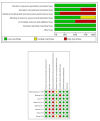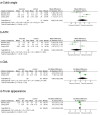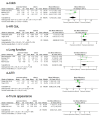The effects of exercise on patients with moderate adolescent idiopathic scoliosis : a systematic review and meta-analysis
- PMID: 40476023
- PMCID: PMC12139610
- DOI: 10.52965/001c.137661
The effects of exercise on patients with moderate adolescent idiopathic scoliosis : a systematic review and meta-analysis
Abstract
Purpose: The effectiveness of exercise therapy for moderate adolescent idiopathic scoliosis and its potential benefits when combined with other treatments require further investigation. This systematic review and meta-analysis evaluated the efficacy of exercise therapy as a conservative management strategy for AIS.
Methods: Following PRISMA guidelines, we searched PubMed, Cochrane Library, Embase, and Web of Science up to June 4, 2024, for RCTs. Eligible studies included AIS patients (10-18 years, Cobb angle 20°-45°) undergoing various exercise therapies, such as scoliosis-specific exercises and core stabilization training. Primary outcomes included Cobb angle, ATR, trunk appearance, QoL, and respiratory function. Data extraction and risk-of-bias assessment followed Cochrane guidelines, and study quality was evaluated using the 11-item PEDro scale. Meta-analyses were conducted based on standardized mean differences.
Results: Eight RCTs with nine intervention groups were analyzed. At six months, exercise alone showed no significant advantage over bracing in improving Cobb angle, ATR, QoL, or trunk appearance (p < 0.05). However, exercise combined with other therapies significantly improved Cobb angle (MD = -6.11, 95% CI: -9.21 to -3.02), QoL (SMD = 0.89, 95% CI: 0.27 to 1.51), and lung function (SMD = 0.46, 95% CI: 0.13 to 0.80) at three months. These effects persisted for Cobb angle at six months (MD = -4.87, 95% CI: -8.77 to -0.98).
Conclusions: Low to moderate evidence suggests exercise alone is comparable to bracing for AIS, while exercise combined with other therapies offers short-term benefits for Cobb angle, QoL, and lung function.
Keywords: Exercise; Meta-analysis; Scoliosis; Systematic review.
Conflict of interest statement
The authors of this article have no financial affiliations (including research funding) or involvement with any commercial organization to disclose.
Figures




forest plot of Cobb angle; b) forest plot of QoL; c) forest plot of lung function.; d) forest plot of Trunk Rotation Angle; e) forest plot of trunk appearance.

forest plot of Cobb angle; b) forest plot of lung function.
Similar articles
-
The efficacy of core stabilization exercise in mild and moderate adolescent idiopathic scoliosis: a systematic review and meta-analysis.J Orthop Surg Res. 2025 Feb 28;20(1):214. doi: 10.1186/s13018-025-05612-7. J Orthop Surg Res. 2025. PMID: 40016756 Free PMC article.
-
Screening for Adolescent Idiopathic Scoliosis: A Systematic Evidence Review for the U.S. Preventive Services Task Force [Internet].Rockville (MD): Agency for Healthcare Research and Quality (US); 2018 Jan. Report No.: 17-05230-EF-1. Rockville (MD): Agency for Healthcare Research and Quality (US); 2018 Jan. Report No.: 17-05230-EF-1. PMID: 29638297 Free Books & Documents. Review.
-
The effectiveness of Schroth method in Cobb angle, quality of life and trunk rotation angle in adolescent idiopathic scoliosis: a systematic review and meta-analysis.Eur J Phys Rehabil Med. 2023 Apr;59(2):228-236. doi: 10.23736/S1973-9087.23.07654-2. Epub 2023 Jan 24. Eur J Phys Rehabil Med. 2023. PMID: 36692412 Free PMC article.
-
Effectiveness of scoliosis-specific exercises for alleviating adolescent idiopathic scoliosis: a systematic review.BMC Musculoskelet Disord. 2020 Jul 27;21(1):495. doi: 10.1186/s12891-020-03517-6. BMC Musculoskelet Disord. 2020. PMID: 32718339 Free PMC article.
-
Evaluating exercise therapies in adolescent idiopathic scoliosis: a systematic review with Bayesian network meta-analysis.PeerJ. 2025 Mar 31;13:e19175. doi: 10.7717/peerj.19175. eCollection 2025. PeerJ. 2025. PMID: 40183057 Free PMC article.
References
LinkOut - more resources
Full Text Sources
Miscellaneous

